Cellular Automata Modeling as a Tool in Corrosion Management
Abstract
:1. Introduction
2. Cellular Automata as Tools in Corrosion Management
2.1. Fundamentals of Cellular Automata for Corrosion
2.1.1. Uniform Corrosion Model
2.1.2. Localized and Pitting Corrosion Model
2.1.3. Stress Corrosion Cracking (SCC) Model
2.1.4. Intergranular Corrosion Model
3. Modeling Approach and Methodology for Simulating Corrosion Phenomena
| Cellular Automata Type | Neighborhood | Model Type | Boundary | Lattice Size | Rules | Cycles | Corrosion Type | Electrolyte | Material | Temperature (°C) | Exposure Time (h) | Validation Type | Ref. |
|---|---|---|---|---|---|---|---|---|---|---|---|---|---|
| LGA | n−vector | Probabilistic | Periodic | - | - | - | - | - | - | - | - | Boltzmann hypothesis | [71] |
| 2D | n−vector | Probabilistic | Periodic | 200 × 160 | 3 | 48,000 | Kinetic of internal oxide precipitation | Oxygen | Theoretical Metal | - | - | Theory of phase equilibrium | [72] |
| Theoretical | Moore | Probabilistic | Periodic | >1000 × 1000 | 8 | - | Uniform | Theoretical Electrolyte | Theoretical Metal | - | - | Previous work data | [31] |
| 2D | Von Neumann | Probabilistic | Periodic | 2000 × 1000 | 2 | 10,000 to 90,000 | Uniform | Theoretical Electrolyte | Theoretical Metal | - | - | - | [37] |
| 2D | Von Neumann | Probabilistic | Periodic | 1000 × 1000 | 3 | 200,000 | Uniform | Theoretical Ionic Solution | Theoretical Metal | - | - | Parabolic law | [38] |
| 2D | Von Neumann | Deterministic | Periodic | 600 × 20,000 | 2 | 150 | Uniform | Theoretical Electrolyte | Theoretical Metal | - | - | Mott and Cabrera Parabolic’s law | [39] |
| 2D | Von Neumann | Probabilistic | Periodic | 1000 × 1000 | 2 | 25,000 | Uniform | Lead−bismuth Eutectic | Stainless Steel | 550 | 3000 | Wagner theory | [40] |
| 3D | - | - | - | 100 × 100 | - | - | Intergranular | Sulfuric Acid | AISI 304 and AISI 316 SS | 1100 | 0−400 | Electrochemical potentiodynamic reactivation | [61] |
| 2D | Moore | Probabilistic | - | 500 × 500 | 2 | 200,000 | Uniform | Lead−bismuth Eutectic | Stainless Steel (Fe, Cr) | 535 | 3000 | Wagner theory | [41] |
| LGA-2D | Von Neumann | Probabilistic | - | 2000 × Ly | 3 | - | Passivation | Theoretical Electrolyte | Theoretical Metal | - | - | Passivation theory | [73] |
| 2D | Moore | Deterministic | - | 200 × 200 | 2 | 3 | Intergranular | Sensitization Treatments | SS 316 | 1100 | 2 | - | [62] |
| 2D | Von Neumann | Probabilistic | Periodic | - | 2 | 7,200,000 | Localized | Theoretical Electrolyte | Theoretical Metal | 360 | - | Experimental | [48] |
| 2D | Von Neumann | Probabilistic | - | 1000 × 1000 | 399,577 | Localized | Theoretical Electrolyte | Theoretical Metal | - | - | Pistorius experimental results | [49] | |
| 2D-3D | Moore | Probabilistic | Periodic | 640 × 320–240 × 280 × 240 | 3 | - | Intergranular | Chloride Solutions | AA2024 Alloy | - | 144 | Eperimental | [63] |
| LGA-2D | Von Neumann | Probabilistic | - | 2000 × Ly | 2 | - | Passivation | Theoretical Electrolyte | Theoretical Metal | - | - | Passivation theory | [74] |
| 2D | Moore | Probabilistic | - | 500 × 500 | 2 | 5000 | Uniform | Supercritical Water | Inconel 625 | 600 | 1000 | Experimental | [42] |
| 2D | Von Neumann | Probabilistic | Periodic | 900 × 300 | 2 | 70,000 | Uniform, localized | Theoretical Electrolyte | Theoretical Metal | 300–360 | - | Experimental | [22] |
| 2D | Von Neumann and Moore | Probabilistic | Periodic | 1000 × 1000 | 14 | 7679 | Localized, passivation | Theoretical Electrolyte | Theoretical Metal | - | - | Theoretical corrosion and passivity phenomena | [75] |
| 2D | Von Neumann and Moore | Probabilistic | Periodic | 1000 × 1000 | 11 | 4000 | Crevice, passivation | Theoretical Electrolyte | Theoretical Metal | - | - | Experimental | [76] |
| 2D | Moore | Probabilistic | - | 500 × 500 | 2 | 200,000 | Uniform | Lead−bismuth Eutectic | Stainless Steel | - | - | Chi-square of goodness−of−fit | [43] |
| 2D | Von Neumann and Moore | Probabilistic | - | 512 × 512 | 3 | 2000 | Oxidation and nit | Nitrogen | Ni−20Cr−2Ti Alloy | 1100 | 100 | Experimental data | [77] |
| 3D | Moore | Probabilistic | Periodic | 151 × 200 × 200 | 3 | 200 | Pitting | Hydrogen Carbonate Solution | AISI 1040 | - | 0.5 | Experimental data | [78] |
| 2D | Von Neumann and Moore | Probabilistic | - | 512 × 512 | 3 | 20,000 | Oxidation and nitridation | Nitrogen | Ni−20Cr−2Ti Alloy | 1100 | 100 | Experimental data | [79] |
| 3D | Moore | Probabilistic | Periodic | - | 4 | 124 | Pitting | Concrete Pore Solution | Q235 Carbon Steel | - | 480 | Experimantal data | [80] |
| 2D | Moore and Von Neumann 2nd order | Probabilistic | - | 1000 × 1000 | 4 | 1000 | Pitting | Theoretical Solution | Theoretical Metal | - | - | Experimental data | [81] |
| 2D | Von Neumann | Probabilistic | - | 1024 × 1024 | 2 | - | Pitting | Neutral Solution | Stainless Steel | - | - | Experimental data | [50] |
| 2D | Moore | Deterministic | Reflect | - | 2 | - | Pitting | Theoretical Solution | Theoretical Metal | - | - | Experimental data | [82] |
| 2D | Von Neumann | Probabilistic | Periodic | 1024 × 1024 | 5 | - | Pitting | Chloride Solution | Stainless Steel | - | - | Experimental data | [51] |
| 2D | Von Neumann 2nd order | Probabilistic | - | - | 3 | - | Pitting | Ferrous Chloride | D16T Alloy | Room | - | Experimental data | [52] |
| 2D | Von Neumann | Probabilistic | Periodic | 2000 × 2000 | 3 | 6000 | Pitting | Water | Alloy 690 | - | 1600 | Experimental data | [53] |
| 2D | Von Neumann and Moore | Probabilistic | - | 500 × 500 | 3 | 3000 | Intergranular | Air | Ni−Cr20−2Ti−Mn Steel and Inconel 625Si | 1100 | 100 | Experimental data | [64] |
| 3D | Moore | Probabilistic | - | 512 × 512 × 512 | 4 | >5000 | Occluded, localized | Theoretical Acid−base Solution | Theoretical Metal | - | - | Experimental data | [56] |
| 3D | - | Probabilistic | Periodic | 512 × 512 × 4096 | - | 4000 | Intragranular | Acid Solution | Stainless Steel | - | 7000 | Experimental data | [66] |
| 2D | Von Neumann | Probabilistic | - | - | 3 | 25,000 | Electrochemical oxidation | HClO4 Aqueous Solution | Ketjenblack ES DJ 600 | 600 | 30 | Experimental data | [83] |
| 2D | Von Neumann and Moore | Probabilistic | - | 512 × 512 | 3 | - | Intergranular oxidation | Atmospheric Air | Alloy 80a and X60 Steel | 1100 | 100 | Experimental data | [65] |
| 2D | Moore and Von Neumann extend | Probabilistic | Periodic | 1000 × 1000 | - | 2000 | Uniform | Acid Rain | Concrete Filled Square Steel Tubular Columns | - | - | Theoretical and experimental | [35] |
| 3D | Moore | Probabilistic | - | 256 × 256 × 256 | 7 | 45,000 | Pitting | Theoretical Acid−base Solution | Theoretical Metal | - | - | Experimental data | [34] |
| 3D | Moore | Probabilistic | Periodic | 512 × 512 × 512 | 7 | 7000 | Generalized | Theoretical acid−base Solution | Theoretical Metal | - | - | Experimental data | [84] |
| CA-FE-2D | Moore | Probabilistic | - | 2000 × 1000 | 4 | - | Localized | NaCl | X65 Steel | - | - | Experimental data | [54] |
| 3D | Von Neumann | Probabilistic | Constant and periodic | 100 × 100 × 100 | 4 | 400 | Atmospheric corrosion | Atmospheric Air | Wheatering Steel | - | - | Theoretical and experimental data | [85] |
| 3D | Von Neumann | Deterministic | Periodic | 100 × 100 × 100 | 5 | 1000 | Uniform | Corrosion Solution | Aluminum Alloy | 20 | - | - | [44] |
| 3D | Von Neumann | Probabilistic | - | 7500 × 7500 × 1500 | - | - | Pitting | Salt−Spray | Q345 Steel | 35 | 1440 | Experimental data | [55] |
| 2D | Margolus | Probabilistic | Rigid | 400 × 400 | 4 | 25,000 | Uniform | Chloride Molten Salt | Inconel625 Alloy | 600 | 504 | Experimental data | [32] |
| LGA-3D | Von Neumann | Probabilistic | Periodic | - | - | - | Passivation | Electrolyte Solution | Metal Electrode | - | - | Passivation theory | [86] |
| 3D | 12−neighbors | Probabilistic | Periodic | 1280 × 1280 × 1280 | - | - | Intergranular | Solution | Stainless Steel | - | 2000 | Experimental data | [67] |
| 2D-bi plane | Von Neumann | Probabilistic | - | 500 × 500 | 5 | 100 | Pitting | Solution | Steel Wires | - | - | Experimental data | [87] |
| 3D | - | - | - | 2048 × 2048 × 256 | 3 | 350 | Intergranular | - | Stainless Steel | - | - | Experimental data | [68] |
| 2D | Margolus | Probabilistic | Periodic | 400 × 400 | 7 | 70,000 | Uniform, intergranular | NaCl−CaCl2 Molten Salt | Hastelloy X | 600 | 504 | Experimental data | [46] |
| 3D | Margolus | Probabilistic | Periodic | 1280 × 1280 × 1280 | - | 21,555 | Intergranular | Nitric Acid Solution | AISI 3010L Stainless Steel | 111 | 17,783 | Experimental data | [69] |
| 2D-3D | Margolus | Probabilistic | Periodic | 40 × 400–100 × 100 × 100 | 10 | 50,000 | Intergranular, pitting | NaCl−KCl−ZnCl2 Molten Salt | Inconel 625 Allow | 700 | 168 | Experimental data | [70] |
| 3D | Von Neumann | Probabilistic | Periodic | 1000 × 1000 × 1000 | 5 | - | Uniform, pitting | Sea Water Solution | Q235 Steel | 168 | Experimental data | [45] | |
| 2D | Moore | Probabilistic | - | 1024 × 1024 × 128 | 4 | 2,000,000 | Aqueous | Theoretical Acid−base Solution | Theoretical Metal | 50 | 853 | Experimental data | [88] |
| 2D | Von Neumann | Probabilistic | - | 250 × 250 | 2 | 2000 | Cracking | Electrolyte Solution | Carbon Steel | 27 | - | Experimental data | [59] |
| 3D | Von Neumann | Probabilistic | - | 2000 × 2000 × 1000 | 2 | - | Cracking | Chloride Solution | Steel bar | 23 | 672 | Experimental data | [58] |
| 3D | Moore | Probabilistic | Periodic | 104 × 104 × 104 | 5 | - | Atmospheric corrosion | Atmospheric Air | Structural Steel | - | - | Experimental data | [33] |
4. Future Perspectives and Emerging Trends
5. Conclusions
Author Contributions
Funding
Institutional Review Board Statement
Data Availability Statement
Acknowledgments
Conflicts of Interest
References
- Lucas Granados, B.; Lucas Granados, B.; Sanchez Tovar, R. Corrosion; Editorial de la Universidad Politecnica de Valencia: Valencia, Spain, 2018. [Google Scholar]
- Koch, G.; Varney, J.; Thompson, N.; Moghissi, O.; Gould, M.; Payer, J. International Measures of Prevention, Application, and Economics of Corrosion Technologies Study; NACE International: Houston, TX, USA, 2016. [Google Scholar]
- Kania, H. Corrosion and Anticorrosion of Alloys/Metals: The Important Global Issue. Coatings 2023, 13, 216. [Google Scholar] [CrossRef]
- Xiao, Q.; Jang, C.; Kim, C.; Chen, J.; Jeong, C.; Kim, S.H. Corrosion behavior of Fe-based candidate accident tolerant fuel cladding alloys in spent fuel pool environment—Effect of prior corrosion. J. Nucl. Mater. 2021, 548, 152845. [Google Scholar] [CrossRef]
- Walczak, M.; Pineda, F.; Fernández, Á.G.; Mata-torres, C.; Escobar, R.A. Materials corrosion for thermal energy storage systems in concentrated solar power plants. Renew. Sustain. Energy Rev. 2018, 86, 22–44. [Google Scholar] [CrossRef]
- Schwartz, J.T.; von Neumann, J.; Burks, A.W. Theory of Self-Reproducing Automata. Math. Comput. 1967, 21, 745. [Google Scholar] [CrossRef]
- Javaherdashti, R. Corrosion Management: A Guide for Industry Managers. Corros. Rev. 2003, 21, 311–326. [Google Scholar] [CrossRef]
- Javaherdashti, R. Corrosion knowledge management for managers. Mater. Perform. 2016, 55, 58–61. [Google Scholar]
- Wan, Z.; Yang, J. Research on corrosion management technology of petroleum pipeline and pressure vessel. IOP Conf. Ser. Earth Environ. Sci. 2021, 692, 042057. [Google Scholar] [CrossRef]
- Jaya, A.; Tiong, U.H.; Clark, G. The interaction between corrosion management and structural integrity of aging aircraft. Fatigue Fract. Eng. Mater. Struct. 2012, 35, 64–73. [Google Scholar] [CrossRef]
- Kurth, J.C.; Krauss, P.D.; Foster, S.W. Corrosion Management of Maritime Infrastructure. Transp. Res. Rec. 2019, 2673, 2–14. [Google Scholar] [CrossRef]
- Balamurugan, P.; Chandramohan, P.; Rao, T.S. Corrosion management of carbon steel material: Operational modes influence corrosion rate-an: In vitro study. RSC Adv. 2016, 6, 41122–41129. [Google Scholar] [CrossRef]
- Larché, N.; Dézerville, P.; Le Flour, D. Corrosion and corrosion management investigations in seawater reverse osmosis desalination plants. Desalin. Water Treat. 2013, 51, 1744–1761. [Google Scholar] [CrossRef]
- Liu, L.; Tan, E.; Cai, Z.Q.; Zhen, Y.; Yin, X.J. An Integrated Coating Inspection System for Marine and Offshore Corrosion Management. In Proceedings of the 2018 15th International Conference on Control, Automation, Robotics and Vision (ICARCV), Singapore, 18–21 November 2018; pp. 1531–1536. [Google Scholar] [CrossRef]
- Choudhury, M.R.; Hsieh, M.K.; Vidic, R.D.; Dzombak, D.A. Corrosion management in power plant cooling systems using tertiary-treated municipal wastewater as makeup water. Corros. Sci. 2012, 61, 231–241. [Google Scholar] [CrossRef]
- Kamrunnahar, M.; Urquidi-Macdonald, M. Prediction of corrosion behavior using neural network as a data mining tool. Corros. Sci. 2010, 52, 669–677. [Google Scholar] [CrossRef]
- Beavers, J.A.; Sridhar, N.; Boomer, K.D. Corrosion management of the Hanford high-level nuclear waste tanks. JOM 2014, 66, 491–502. [Google Scholar] [CrossRef]
- Yazdi, M.; Khan, F.; Abbassi, R. Microbiologically influenced corrosion (MIC) management using Bayesian inference. Ocean Eng. 2021, 226, 108852. [Google Scholar] [CrossRef]
- Milazzo, M.F.; Piperopoulos, E.; Khaskhoussi, A.; Scionti, G. Investigation of the bottom corrosion of atmospheric storage tanks for the management of safety. In Proceedings of the GRICU, Montegrotto Terme, Italy, 3–6 July 2022; pp. 35–38. [Google Scholar]
- Shafeek, H.; Soltan, H.A.; Abdel-Aziz, M.H. Corrosion monitoring in pipelines with a computerized system. Alexandria Eng. J. 2021, 60, 5771–5778. [Google Scholar] [CrossRef]
- Hussain, M.; Zhang, T.; Seema, M.N.; Hussain, A. Application of big data analytics to energy pipeline corrosion management. Corros. Manag. 2021, 2021, 28–29. [Google Scholar] [CrossRef]
- Di Caprio, D.; Vautrin-Ul, C.; Stafiej, J.; Saunier, J.; Chaussé, A.; Féron, D.; Badiali, J.P. Morphology of corroded surfaces: Contribution of cellular automaton modelling. Corros. Sci. 2011, 53, 418–425. [Google Scholar] [CrossRef]
- López De La Cruz, J.; Kuniewski, S.P.; Van Noortwijk, J.M.; Gutiérrez, M.A. Spatial Nonhomogeneous Poisson Process in Corrosion Management. J. Electrochem. Soc. 2008, 155, C396. [Google Scholar] [CrossRef]
- Verma, C.; Lgaz, H.; Verma, D.K.; Ebenso, E.E.; Bahadur, I.; Quraishi, M.A. Molecular dynamics and Monte Carlo simulations as powerful tools for study of interfacial adsorption behavior of corrosion inhibitors in aqueous phase: A review. J. Mol. Liq. 2018, 260, 99–120. [Google Scholar] [CrossRef]
- Vanaei, H.R.; Eslami, A.; Egbewande, A. A review on pipeline corrosion, in-line inspection (ILI), and corrosion growth rate models. Int. J. Press. Vessels Pip. 2017, 149, 43–54. [Google Scholar] [CrossRef]
- Malki, B.; Baroux, B. Computer simulation of the corrosion pit growth. Corros. Sci. 2005, 47, 171–182. [Google Scholar] [CrossRef]
- Khaled, K.F. Monte Carlo simulations of corrosion inhibition of mild steel in 0.5 M sulphuric acid by some green corrosion inhibitors. J. Solid State Electrochem. 2009, 13, 1743–1756. [Google Scholar] [CrossRef]
- Cox, W.M. A strategic approach to corrosion monitoring and corrosion management. Procedia Eng. 2014, 86, 567–575. [Google Scholar] [CrossRef]
- Garcia, R.L.; Happ, P.N.; Feitosa, R.Q. Large scale semantic segmentation of virtual environments to facilitate corrosion management. Int. Arch. Photogramm. Remote Sens. Spat. Inf. Sci.—ISPRS Arch. 2021, 43, 465–470. [Google Scholar] [CrossRef]
- Li, L.; Chakik, M.; Prakash, R. A review of corrosion in aircraft structures and graphene-based sensors for advanced corrosion monitoring. Sensors 2021, 21, 2908. [Google Scholar] [CrossRef]
- Córdoba-Torres, P.; Nogueira, R.P.; De Miranda, L.; Brenig, L.; Wallenborn, J.; Fairén, V. Cellular automaton simulation of a simple corrosion mechanism: Mesoscopic heterogeneity versus macroscopic homogeneity. Electrochim. Acta 2001, 46, 2975–2989. [Google Scholar] [CrossRef]
- Wang, W.; Guan, B.; Wei, X.; Lu, J.; Ding, J. Cellular automata simulation on the corrosion behavior of Ni-base alloy in chloride molten salt. Sol. Energy Mater. Sol. Cells 2019, 203, 110170. [Google Scholar] [CrossRef]
- Fan, Y.; Pan, J.; Wu, Z.; Li, B.; Wang, Z. A Method for Predicting the Corrosion Behavior of Structural Steel under Atmosphere. Buildings 2023, 13, 253. [Google Scholar] [CrossRef]
- Pérez-Brokate, C.F.; di Caprio, D.; Féron, D.; de Lamare, J.; Chaussé, A. Pitting corrosion modelling by means of a stochastic cellular automata-based model. Corros. Eng. Sci. Technol. 2017, 52, 605–610. [Google Scholar] [CrossRef]
- Chen, M.C.; Wen, Q.Q.; Zhu, Q.; Huang, H.; Xie, L. Simulation of corrosion process for concrete filled steel tubular columns with the cellular automata method. Eng. Fail. Anal. 2017, 82, 298–307. [Google Scholar] [CrossRef]
- Chopard, B.; Droz, M. Cellular Automata Modeling of Physical Systems; Cambridge University Press: Cambridge, UK, 1998. [Google Scholar]
- Taleb, A.; Chaussé, A.; Dymitrowska, M.; Stafiej, J.; Badiali, J.P. Simulations of corrosion and passivation phenomena: Diffusion feedback on the corrosion rate. J. Phys. Chem. B 2004, 108, 952–958. [Google Scholar] [CrossRef]
- Saunier, J.; Chaussé, A.; Stafiej, J.; Badiali, J.P. Simulations of diffusion limited corrosion at the metal|environment interface. J. Electroanal. Chem. 2004, 563, 239–247. [Google Scholar] [CrossRef]
- Saunier, J.; Dymitrowska, M.; Chaussé, A.; Stafiej, J.; Badiali, J.P. Diffusion, interactions and universal behavior in a corrosion growth model. J. Electroanal. Chem. 2005, 582, 267–273. [Google Scholar] [CrossRef]
- Chen, H.; Chen, Y.; Zhang, J. Cellular automaton modeling on the corrosion/oxidation mechanism of steel in liquid metal environment. Prog. Nucl. Energy 2008, 50, 587–593. [Google Scholar] [CrossRef]
- Tan, T.; Chen, Y. Scale removal cellular automaton oxidation models of metals in lead bismuth eutectic. J. Electroanal. Chem. 2009, 626, 89–97. [Google Scholar] [CrossRef]
- Lan, K.C.; Chen, Y.; Yeh, T.K.; Hung, T.C.; Liu, M.L.; Yu, G.P. Scale removal oxidation behavior of metal in supercritical water modeled by cellular automaton. Prog. Nucl. Energy 2011, 53, 1034–1038. [Google Scholar] [CrossRef]
- Lan, K.C.; Chen, Y.; Hung, T.C.; Tung, H.M.; Yu, G.P. Simulation of the growth of oxide layer of stainless steels with chromium using cellular automaton model: Verification and parameter study. Comput. Mater. Sci. 2013, 77, 139–144. [Google Scholar] [CrossRef]
- Ji, H.; Ren, K.; Ding, L.; Wang, T.; Zhang, X.; Li, J.; Zhang, Z.; Guo, D. Three-Dimensional Cellular Automata Model of Uniform Corrosion for Aluminium Alloy; Springer: Singapore, 2019; Volume 459. [Google Scholar]
- Chen, Z.; Sun, L.; Zhang, W.; Zheng, H.; Xia, W.; Zeng, H.; Chen, S.; Li, K.; Li, W. Corrosion behavior of marine structural steel in tidal zone based on wire beam electrode technology and partitioned cellular automata model. Corros. Commun. 2022, 5, 87–97. [Google Scholar] [CrossRef]
- Xu, Z.; Wei, X.; Lu, J.; Ding, J.; Wang, W. Simulation of corrosion behavior of Fe–Cr–Ni alloy in binary NaCl–CaCl2 molten salt using a cellular automata method. Sol. Energy Mater. Sol. Cells 2021, 231, 111301. [Google Scholar] [CrossRef]
- Svintradze, D.V.; Pidaparti, R.M. A theoretical model for metal corrosion degradation. Int. J. Corros. 2010, 2010, 279540. [Google Scholar] [CrossRef]
- Di Caprio, D.; Vautrin-Ul, C.; Stafiej, J.; Chaussé, A.; Féron, D.; Badiali, J.P. Cellular automata approach for morphological evolution of localised corrosion. Corros. Eng. Sci. Technol. 2011, 46, 223–227. [Google Scholar] [CrossRef]
- Li, L.; Li, X.G.; Dong, C.F.; Cheng, Y.F. Cellular automaton model for simulation of metastable pitting. Corros. Eng. Sci. Technol. 2011, 46, 340–345. [Google Scholar] [CrossRef]
- Wang, H.T.; Han, E.H. Cellular automata simulation of interactions between metastable corrosion pits on stainless steel. Mater. Corros. 2015, 66, 925–930. [Google Scholar] [CrossRef]
- Wang, H.; Han, E.H. Computational simulation of corrosion pit interactions under mechanochemical effects using a cellular automaton/finite element model. Corros. Sci. 2016, 103, 305–311. [Google Scholar] [CrossRef]
- Rusyn, B.P.; Tors’Ka, R.V.; Pokhmurs’Kyi, A.Y. Modeling of the evolution of corrosion pitting with the use of cellular automata. Mater. Sci. 2015, 50, 74–80. [Google Scholar] [CrossRef]
- Zhang, X.; Hu, J.; Wang, Y.; Zheng, M.; Zhang, Z. Simulation of pitting corrosion for Ni-based alloy using a cellular automata model. Rare Met. Mater. Eng. 2015, 44, 2347–2352. [Google Scholar] [CrossRef]
- Fatoba, O.O.; Leiva-Garcia, R.; Lishchuk, S.V.; Larrosa, N.O.; Akid, R. Simulation of stress-assisted localised corrosion using a cellular automaton finite element approach. Corros. Sci. 2018, 137, 83–97. [Google Scholar] [CrossRef]
- Cui, C.; Ma, R.; Chen, A.; Pan, Z.; Tian, H. Experimental study and 3D cellular automata simulation of corrosion pits on Q345 steel surface under salt-spray environment. Corros. Sci. 2019, 154, 80–89. [Google Scholar] [CrossRef]
- Pérez-Brokate, C.F.; di Caprio, D.; Féron, D.; de Lamare, J.; Chaussé, A. Three dimensional discrete stochastic model of occluded corrosion cell. Corros. Sci. 2016, 111, 230–241. [Google Scholar] [CrossRef]
- Fu, J.; Zhou, Q.; Li, N.; Liu, Z.; Liu, T. Effects of external stresses on hot corrosion behavior of stainless steel TP347HFG. Corros. Sci. 2016, 104, 103–111. [Google Scholar] [CrossRef]
- Al-samawi, M.; Zhu, J.; Rong, W. Application of 3D cellular automata-based analysis to chloride diffusion process in concrete bridges. Structures 2023, 47, 500–519. [Google Scholar] [CrossRef]
- Gong, K.; Wu, M.; Liu, X.; Liu, G. Nucleation and propagation of stress corrosion cracks: Modeling by cellular automata and finite element analysis. Mater. Today Commun. 2022, 33, 104886. [Google Scholar] [CrossRef]
- Marcus, P. Corrosion Mechanisms in Theory and Practice; CRC Press: Boca Raton, FL, USA, 1996; Volume 34. [Google Scholar]
- Yu, X.; Chen, S. A simulation of Cr depletion in austenitic stainless steel with cellular automaton. Comput. Mater. Sci. 2009, 45, 899–904. [Google Scholar] [CrossRef]
- Yu, X.; Chen, S.; Liu, Y.; Ren, F. A study of intergranular corrosion of austenitic stainless steel by electrochemical potentiodynamic reactivation, electron back-scattering diffraction and cellular automaton. Corros. Sci. 2010, 52, 1939–1947. [Google Scholar] [CrossRef]
- Lishchuk, S.V.; Akid, R.; Worden, K.; Michalski, J. A cellular automaton model for predicting intergranular corrosion. Corros. Sci. 2011, 53, 2518–2526. [Google Scholar] [CrossRef]
- Jahns, K.; Balinski, K.; Landwehr, M.; Wübbelmann, J.; Krupp, U. Prediction of high temperature corrosion phenomena by the cellular automata approach. Mater. Corros. 2016, 68, 125–132. [Google Scholar] [CrossRef]
- Jahns, K.; Balinski, K.; Landwehr, M.; Trindade, V.B.; Wübbelmann, J.; Krupp, U. Modeling of Intergranular Oxidation by the Cellular Automata Approach. Oxid. Met. 2017, 87, 285–295. [Google Scholar] [CrossRef]
- di Caprio, D.; Stafiej, J.; Luciano, G.; Arurault, L. 3D cellular automata simulations of intra and intergranular corrosion. Corros. Sci. 2016, 112, 438–450. [Google Scholar] [CrossRef]
- Guiso, S.; di Caprio, D.; de Lamare, J.; Gwinner, B. Intergranular corrosion: Comparison between experiments and cellular automata. Corros. Sci. 2020, 177, 108953. [Google Scholar] [CrossRef]
- Guiso, S.; di Caprio, D.; de Lamare, J.; Gwinner, B. Influence of the grid cell geometry on 3D cellular automata behavior in intergranular corrosion. J. Comput. Sci. 2021, 53, 101322. [Google Scholar] [CrossRef]
- Guiso, S.; Brijou-Mokrani, N.; de Lamare, J.; Di Caprio, D.; Gwinner, B.; Lorentz, V.; Miserque, F. Intergranular corrosion in evolving media: Experiment and modeling by cellular automata. Corros. Sci. 2022, 205, 110457. [Google Scholar] [CrossRef]
- Xu, Z.; Lu, J.; Wei, X.; Ding, J.; Wang, W. 2D and 3D cellular automata simulation on the corrosion behaviour of Ni-based alloy in ternary molten salt of NaCl–KCl–ZnCl 2. Sol. Energy Mater. Sol. Cells 2022, 240, 111694. [Google Scholar] [CrossRef]
- Boon, J.P.; David, D.; Kapral, R.; Lawniczak, A. Lattice gas automata for reactive systems. Phys. Rep. 1996, 273, 55–147. [Google Scholar] [CrossRef]
- Zhou, L.; Wei, X. A randomwalk-cellular automaton model of precipitation of internal oxides. Scr. Mater. 1997, 37, 1483–1489. [Google Scholar] [CrossRef]
- Di Caprio, D.; Stafiej, J. Simulations of passivation phenomena based on discrete lattice gas automata. Electrochim. Acta 2010, 55, 3884–3890. [Google Scholar] [CrossRef]
- Di Caprio, D.; Stafiej, J. The role of adsorption in passivation phenomena modelled by discrete lattice gas automata. Electrochim. Acta 2011, 56, 3963–3968. [Google Scholar] [CrossRef]
- Bartosik, Ł.; di Caprio, D.; Stafiej, J. Cellular automata approach to corrosion and passivity phenomena. Pure Appl. Chem. 2013, 85, 247–256. [Google Scholar] [CrossRef]
- Stafiej, J.; Di Caprio, D.; Bartosik, Ł. Corrosion-passivation processes in a cellular automata based simulation study. J. Supercomput. 2013, 65, 697–709. [Google Scholar] [CrossRef]
- Jahns, K.; Landwehr, M.; Wübbelmann, J.; Krupp, U. Numerical analysis of internal oxidation and nitridation by the cellular automata approach. Oxid. Met. 2013, 79, 107–120. [Google Scholar] [CrossRef]
- Van der Weeën, P.; Zimer, A.M.; Pereira, E.C.; Mascaro, L.H.; Bruno, O.M.; De Baets, B. Modeling pitting corrosion by means of a 3D discrete stochastic model. Corros. Sci. 2014, 82, 133–144. [Google Scholar] [CrossRef]
- Jahns, K.; Landwehr, M.; Wübbelmann, J.; Krupp, U. Numerical analysis of high temperature internal corrosion mechanisms by the cellular automata approach. Mater. Corros. 2014, 65, 305–311. [Google Scholar] [CrossRef]
- Qiao, G.; Hong, Y.; Ou, J. Quantitative monitoring of pitting corrosion based on 3-D cellular automata and real-time ENA for RC structures. Meas. J. Int. Meas. Confed. 2014, 53, 270–276. [Google Scholar] [CrossRef]
- Rusyn, B.; Tors’Ka, R.; Kobasyar, M. Application of the cellular automata for obtaining pitting images during simulation process of their growth. Adv. Intell. Syst. Comput. 2014, 242, 299–306. [Google Scholar] [CrossRef]
- Da Silva, N.R.; Van der Weeën, P.; De Baets, B.; Bruno, O.M. Improved texture image classification through the use of a corrosion-inspired cellular automaton. Neurocomputing 2015, 149, 1560–1572. [Google Scholar] [CrossRef]
- Kireeva, A.E.; Sabelfeld, K.K.; Maltseva, N.V.; Gribov, E.N. Parallel implementation of cellular automaton model of the carbon corrosion under the influence of the electrochemical oxidation. In Parallel Computing Technologies; Lecture Notes in Computer Science (Including Subseries Lecture Notes in Artificial Intelligence and Lecture Notes in Bioinformatics); Springer: Berlin/Heidelberg, Germany, 2017; Volume 10421, pp. 205–214. [Google Scholar] [CrossRef]
- Pérez-Brokate, C.F.; di Caprio, D.; Féron, D.; de Lamare, J.; Chaussé, A. Probabilistic cellular automata model of generalised corrosion, transition to localised corrosion. Corros. Eng. Sci. Technol. 2017, 52, 186–193. [Google Scholar] [CrossRef]
- Zhu, J.S.; Guo, X.Y.; Kang, J.F. 3D Cellular Automata Based Numerical Simulation of Atmospheric Corrosion Process on Weathering Steel. In Maintenance, Safety, Risk, Management and Life-Cycle Performance of Bridges, Proceedings of the 9th International Conference on Bridge Maintenance, Safety and Management—IABMAS 2018, Melbourne, Australia, 9–13 July 2018; CRC Press: Boca Raton, FL, USA, 2018; Volume 30, pp. 1791–1797. [Google Scholar] [CrossRef]
- Stępień, J.; di Caprio, D.; Stafiej, J. 3D simulations of the metal passivation process in potentiostatic conditions using discrete lattice gas automaton. Electrochim. Acta 2019, 295, 173–180. [Google Scholar] [CrossRef]
- Guo, Z.W.; Chen, H. Monte Carlo Simulation Method for Pit Erosion Process of Cable Wire Based on Bi-plane Cellular Automata. Int. J. Steel Struct. 2020, 20, 1527–1539. [Google Scholar] [CrossRef]
- Zenkri, M.; di Caprio, D.; Raouafi, F.; Féron, D. Cathodic control using cellular automata approach. Mater. Corros. 2022, 73, 1631–1643. [Google Scholar] [CrossRef]
- Marzo, A.; Trigo, M.; Alonso-Montesinos, J.; Martínez-Durbán, M.; López, G.; Ferrada, P.; Fuentealba, E.; Cortés, M.; Batlles, F.J. Daily global solar radiation estimation in desert areas using daily extreme temperatures and extraterrestrial radiation. Renew. Energy 2017, 113, 303–311. [Google Scholar] [CrossRef]
- Fernández, A.G.; Cabeza, L.F. Corrosion monitoring and mitigation techniques on advanced thermal energy storage materials for CSP plants. Sol. Energy Mater. Sol. Cells 2019, 192, 179–187. [Google Scholar] [CrossRef]

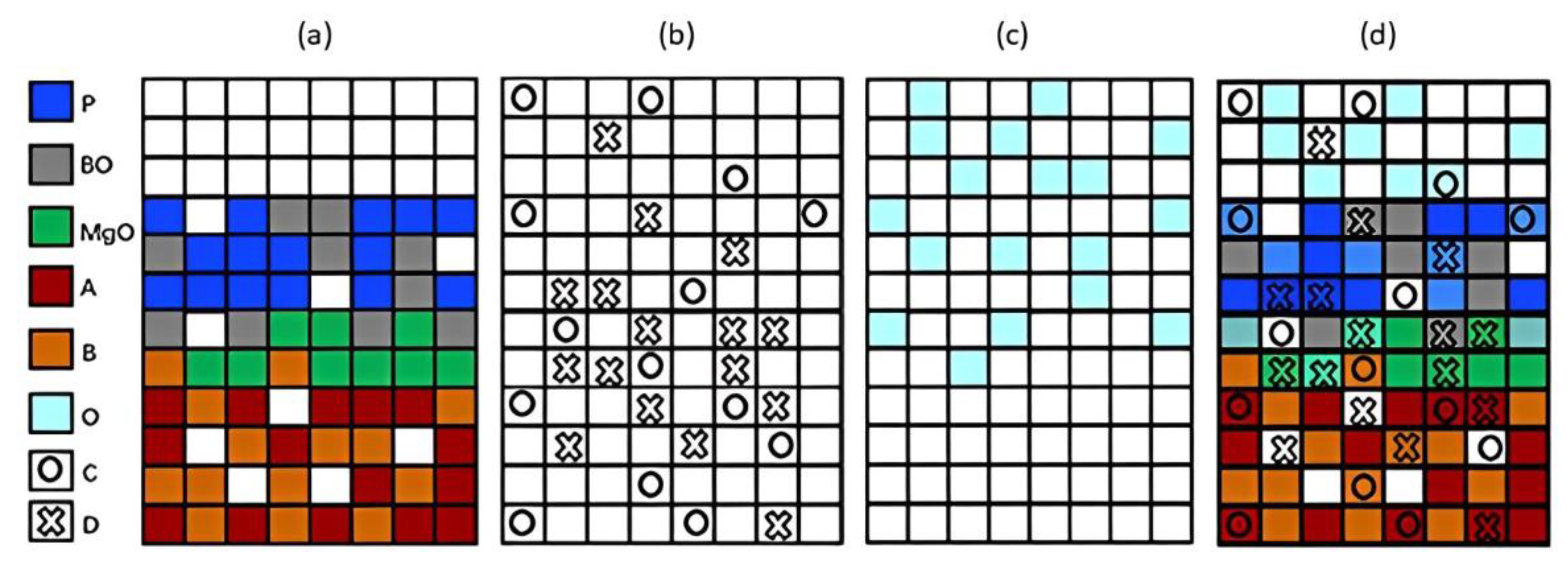

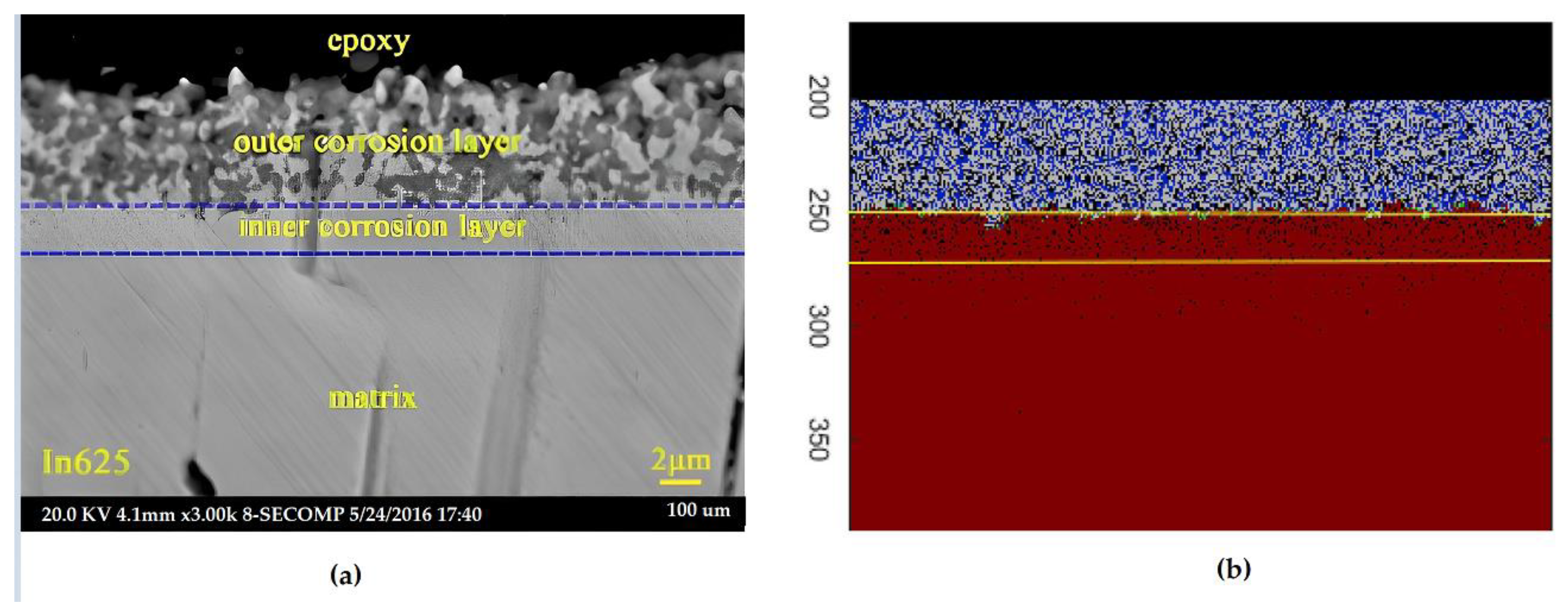
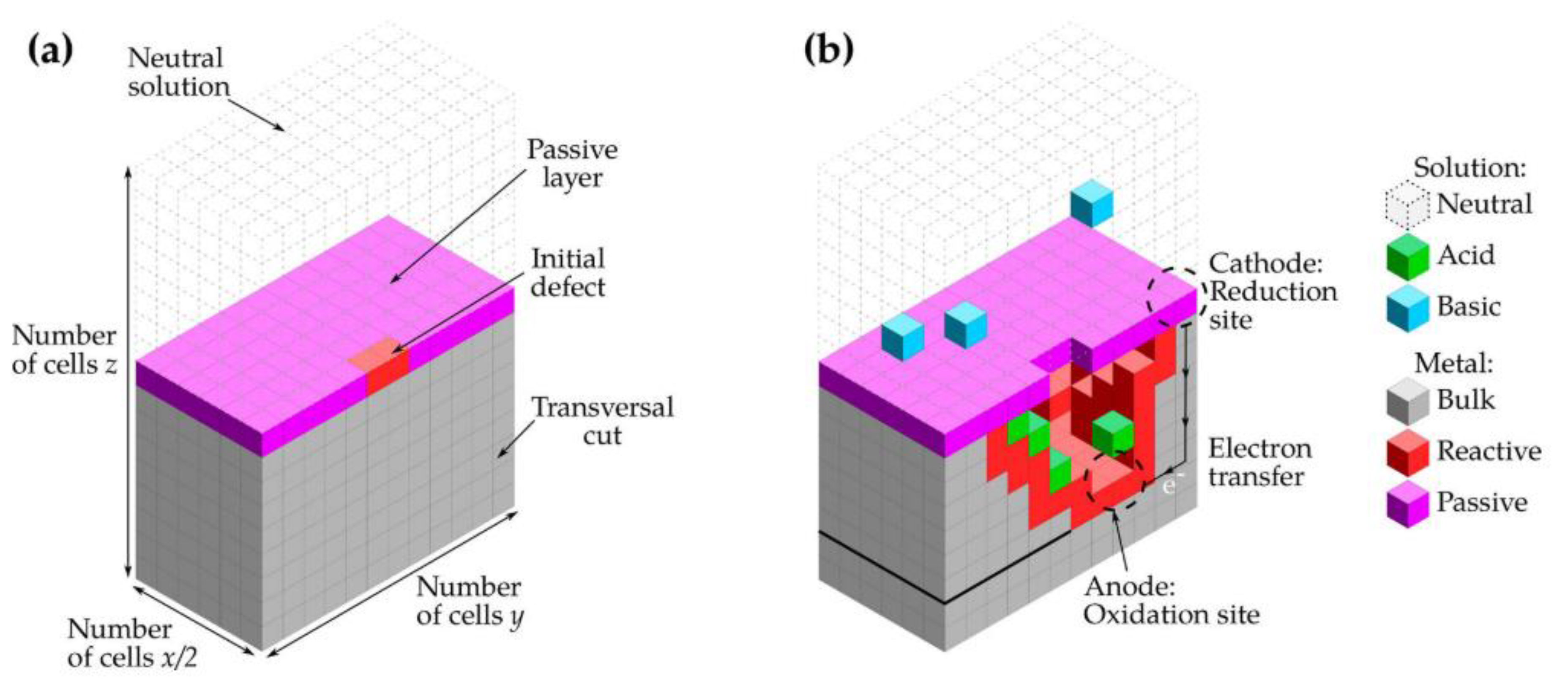


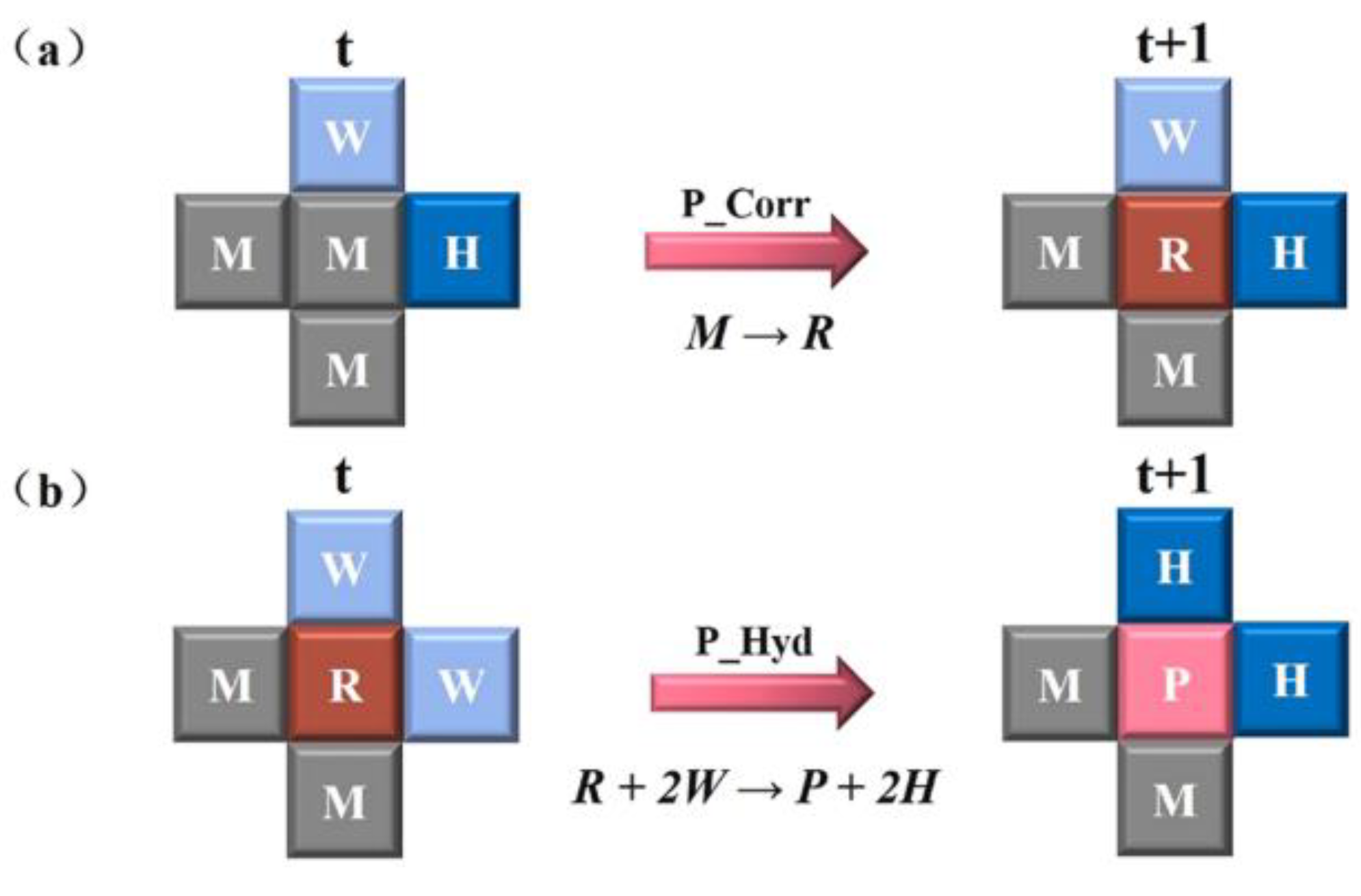
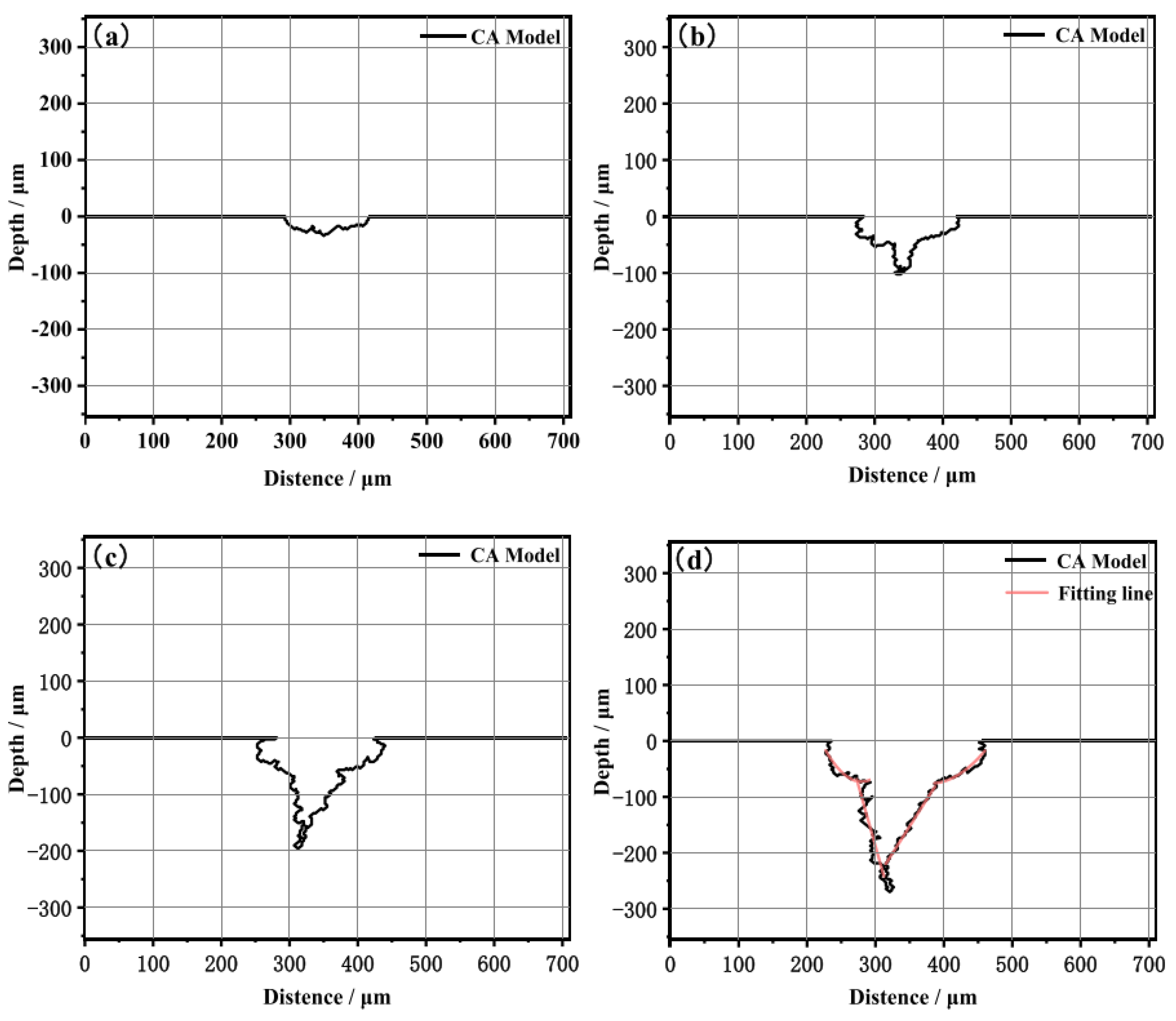


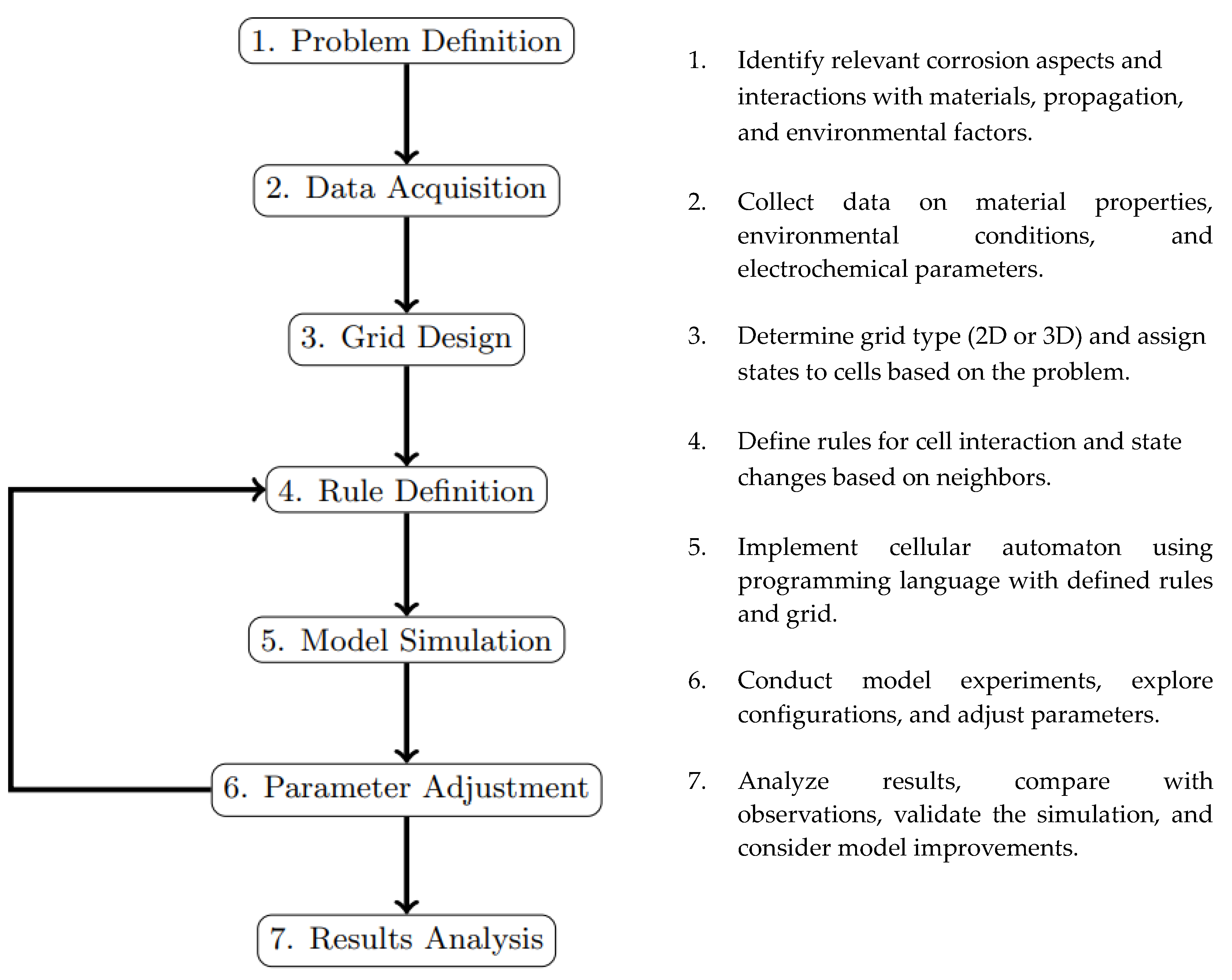
Disclaimer/Publisher’s Note: The statements, opinions and data contained in all publications are solely those of the individual author(s) and contributor(s) and not of MDPI and/or the editor(s). MDPI and/or the editor(s) disclaim responsibility for any injury to people or property resulting from any ideas, methods, instructions or products referred to in the content. |
© 2023 by the authors. Licensee MDPI, Basel, Switzerland. This article is an open access article distributed under the terms and conditions of the Creative Commons Attribution (CC BY) license (https://creativecommons.org/licenses/by/4.0/).
Share and Cite
Reinoso-Burrows, J.C.; Toro, N.; Cortés-Carmona, M.; Pineda, F.; Henriquez, M.; Galleguillos Madrid, F.M. Cellular Automata Modeling as a Tool in Corrosion Management. Materials 2023, 16, 6051. https://doi.org/10.3390/ma16176051
Reinoso-Burrows JC, Toro N, Cortés-Carmona M, Pineda F, Henriquez M, Galleguillos Madrid FM. Cellular Automata Modeling as a Tool in Corrosion Management. Materials. 2023; 16(17):6051. https://doi.org/10.3390/ma16176051
Chicago/Turabian StyleReinoso-Burrows, Juan C., Norman Toro, Marcelo Cortés-Carmona, Fabiola Pineda, Mauro Henriquez, and Felipe M. Galleguillos Madrid. 2023. "Cellular Automata Modeling as a Tool in Corrosion Management" Materials 16, no. 17: 6051. https://doi.org/10.3390/ma16176051






